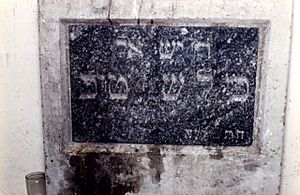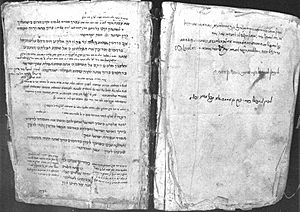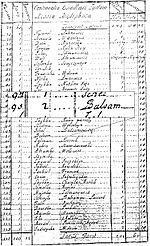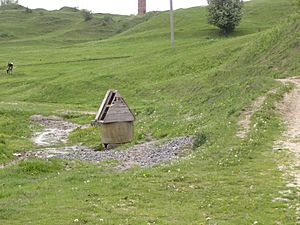Baal Shem Tov facts for kids
Quick facts for kids Baal Shem Tov |
|
|---|---|
| Signature | |
| Born | 1698 Okopy Świętej Trójcy, Kingdom of Poland (now Ukraine) |
| Died | 22 May 1760 (6 Sivan 5520) Międzybóż, Podolian Voivodeship, Kingdom of Poland (now Ukraine) |
| Buried | Międzybóż |
| Successor | Dov Ber of Mezeritch (1704–1772) |
| Father | Eliezer |
| Mother | Sara |
Israel ben Eliezer (1698 – 22 May 1760) was a special Jewish leader. He is best known as the Baal Shem Tov (meaning "Master of the Good Name"). People also called him the Besht. He was a Jewish mystic and healer. Many people see him as the founder of Hasidic Judaism, a branch of Judaism.
The name "Baal Shem Tov" means "Master of the Good Name." It was a title for someone who could use secret names of God for healing or other special abilities. Most of what we know about the Besht comes from stories passed down by his students. There are also many legendary tales about his life. These stories were collected in a book called Shivḥei ha-Besht (In Praise of the Ba'al Shem Tov).
A main idea in the Baal Shem Tov's teachings is dvekut. This means having a direct connection with God. He believed this connection is part of every human activity. It should be felt every waking hour. Prayer was very important to him. He also taught about the special meaning of Hebrew letters and words. He encouraged people to find God in their everyday thoughts. His followers believe he came from the family line of King David.
Contents
Who Was the Baal Shem Tov?
His Early Life
Israel was born to poor parents, Eliezer and Sarah, in a small village. This village was near Okopy, Ternopil Oblast in what is now Ukraine. He became an orphan in 1703. The Jewish community of Tluste adopted him.
After finishing cheder (a Jewish elementary school), he loved to explore the fields and forests. Around 1710, he became an assistant to a melamed (a teacher in a cheder). He later worked as a shammash (a synagogue helper).
The Baal Shem Tov enjoyed taking children to and from school. He would pray with them and tell them Torah stories. His successor, the Mezritcher Maggid, once said: "If only we kissed a Torah scroll with the same love that my master kissed the children!"
He traveled around Eastern Galicia. He worked as a helper in small communities. Later, he settled as a teacher in Tluste. He learned about Kabbalah, which is a mystical part of Jewish tradition. He was taught by Rabbi Adam Baal Shem.
The Besht became a leader of a group of special individuals. They cared for poor Jews. They encouraged Jews to live on farms. This was an alternative to the poverty in cities. They also made sure children in farm communities had teachers. The Baal Shem Tov himself became a teacher's assistant. He said his happiest time was teaching children basic prayers.
People often asked him to settle their disagreements. He was a good mediator and arbitrator. This was important because Jews in Poland had their own courts. He married a woman named Chana. They moved to a village in the Carpathian Mountains. They earned money by digging clay and lime. Chana would deliver these materials to nearby villages. They had two children, Udl and Zvi Hersh. A famous great-grandson of his was Reb Nachman of Breslov.
Becoming a Leader
The Besht later worked as a shohet (a ritual butcher). He then managed a village tavern. During his time in the woods, he learned to use plants for healing. His first public role was as a "Baal Shem." He would write special amulets and suggest cures.
After many travels, the Besht felt he had enough followers. Around 1740, he decided to share his teachings in Medzhybizh. Many people, especially spiritual leaders, came to hear him. Medzhybizh became the center of the Hasidic movement. His followers grew, but some traditional scholars disagreed with him.
However, some important rabbis supported him. These included Rabbi Jacob Joseph of Polonne and Rabbi Dov Ber of Mezeritch. Rabbi Dov Ber helped spread the Besht's ideas to more learned Jewish circles.
Israel traveled, performing cures and helping people. He was known for expelling evil spirits. Later, Hasidic tradition focused more on his teachings. They emphasized his charm and spiritual personality.
Today, many graves of Jewish leaders in Ukraine have been restored. This includes the Baal Shem Tov's grave. A guesthouse and synagogue are now next to his grave. His synagogue in the village has also been restored. Many visitors come from all over the world to pray there.
Disputes with the Frankists
The Besht was involved in disagreements with the Frankists. This was a group led by Jacob Frank. They believed Frank was the Messiah. The Baal Shem Tov was very sad when many Frankists left Judaism. Some say he died from this grief.
His Lasting Impact
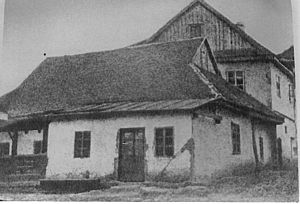
Israel ben Eliezer did not write any books himself. His teachings are found in the writings of his students. Rabbi Jacob Joseph of Polnoy recorded many of his sayings. After his death, Hasidism split into different groups. Each group claimed to follow the Besht's true teachings. So, it can be tricky to know which sayings are truly his.
Some historical records exist about the Besht in Medzhybizh. Documents from Polish noble families show his house was tax-free. These records suggest the Besht and his followers were respected. They were not outcasts in the Jewish community.
Other direct evidence includes the Besht's own prayer-book. It has his handwritten notes in the margins. This book is now in a library in New York. His grave can still be visited today in Medzhybizh.
Historians believe the Besht appeared at the right time and place. The area of Podolia in the 1700s was recovering from past conflicts. The Jewish community was rebuilding. People were open to new ideas. The Besht's fresh approach to Judaism was welcomed. It spread easily in a community ready for change.
How He Practiced His Faith
The Besht was a mystic. He believed he achieved devekut, a deep connection with God. He felt his soul could "ascend" to heaven. He could speak with souls there and connect humans with God. He also believed he could protect the Jewish community through prayer.
According to some letters, the Besht could see future events. He could also understand the mysteries of God. People also believed he was a great healer. He knew a lot about salves and balms. Some say his healing was through prayer and holy words. Others believed he used more mystical methods.
He had a special custom for Friday nights. He ate farfel (a type of noodle). The word sounded like "wiped out" or "finished." He saw the noodles as a symbol. They marked the end of the old week and the start of a new one.
His Main Teachings
The Besht's teachings come from Kabbalah. But he focused more on the individual person. He taught that personal spiritual growth was needed for the world to be better. He said we must first pray for our own spiritual well-being. He emphasized the individual over a focus on the Messiah.
The main idea of his teaching is devekut. He said this connection with God should be in all daily actions. Even in business or social contacts, one should think of God. He believed that if a person's thoughts are with God, they will be blessed. This means he didn't think people should withdraw from daily life. He was against extreme fasting or living a very strict life.
He believed that physical pleasure could lead to spiritual pleasure. A physical act could become a religious act. This happens if it's done to worship God and with devekut.
Studying the Torah was very important to him. He taught that by thinking deeply about the letters of the Torah, one could connect to divine worlds. He believed the letters came from a heavenly source. By focusing on them, one could connect to their spiritual origin. This could bring mystical insights.
Prayer also helps a person reach devekut and connect with God. This is done by focusing on the mystical meaning of the letters in prayer. He taught that the main goal of Torah study and prayer is to connect to the divine light within the letters.
The Besht also taught about the zaddik. These are special individuals with strong spiritual qualities. They have a higher level of devekut. They guide society and teach people to worship God. They also help sinners find their way back to God.
How He Influenced Hasidism
The Besht's ideas about how humans connect with the universe are key to Hasidism. He taught that true worship is about connecting and becoming one with God. He said that a person who truly feels this oneness has a special intuition. This feeling is like prophecy. This means that a truly spiritual person can have authority similar to prophets. This focus on oneness with God is called Panentheism.
Another important idea is that humans, through their connection with God, link the Creator and creation. The Besht said, "The righteous can give life by their faith." His followers expanded on this. They believed that loving a righteous person could bring God's mercy and blessings.
However, the Baal Shem Tov also gave a warning. He said that worries or doubts about God's plan are like attacks. He taught that people must remove these doubts from their hearts. This way, they can serve God with complete joy.
In Hasidism, the founder is as important as his teachings. The Besht himself is still the main focus for Hasidim. His teachings are sometimes less remembered than his stories. As one scholar noted, to Hasidim, the Baal Shem Tov was the living example of a spiritual idea. His whole life showed a system of belief.
His Teaching Style
The Besht did not fight against traditional Jewish law. He focused on the spiritual side of practicing it. His teachings came from a deep religious feeling. He believed the Law was holy. He also stressed that one's entire life should be dedicated to serving God.
Hasidic stories tell of a woman whose relatives wanted to harm her. She was saved by the Besht. This story shows how he helped those in need. He valued friendly relationships with sinners more than strict prayer. Selflessness and kindness are common themes in stories about him.
The Besht's teaching methods were different from his opponents. He often made fun of them. He called a typical scholar of his time "a man who studies the Law so much he has no time to think about God." He used parables to explain his views.
He strongly believed God gave him a special mission to spread his teachings. He had heavenly visions that showed him this mission. For him, every intuition was a divine message. Divine messages happened daily. For example, he once knew his brother-in-law was not in Israel on a certain Sabbath, even though he was far away.
Legends About Him
In Hasidic tradition, there's a saying: "Someone who believes all the stories about the Baal Shem Tov and other holy men is a fool. Someone who says 'That one could not be true' about any single story is a heretic."
Many legends are told about the Baal Shem Tov. These stories have sometimes changed his historical character. The first collection of these legends was put together by Dov Baer b. Samuel. This collection was copied many times and errors crept in. It was printed as Shivḥei ha-Besht after Dov Baer's death. The first chapter was rewritten to fix mistakes.
This edition, printed in 1814, has 230 stories. They are grouped by themes and characters. Other collections of legends appeared later. Only a few of these stories are likely true.
One legend tells about his father, Eliezer. He was captured and sold as a slave to a prince. Because of his wisdom, he became a minister to the king. He gave good advice that helped the king win a battle. Eliezer became a general and then prime minister. The king offered him the viceroy's daughter in marriage. But Eliezer was already married and a Jew. He only married her in name. When he explained this, the princess helped him escape back to his country.
On his way, the prophet Elijah supposedly appeared to Eliezer. Elijah told him: "Because of your goodness, you will have a son who will bring light to all Israel. His name shall be Israel." Eliezer and his wife Sarah were very old and childless. But when they were nearly a hundred, their promised son, the Besht, was born.
Notable Students
The Baal Shem Tov taught his ideas directly to his students. Some of them went on to start their own Hasidic groups.
- Yaakov Yosef of Polnoy (1710–1784)
- Ze'ev Wolf Kitzes of Medzhybizh (~1685–1788)
- Yechiel Michel of Zlotchov (1721–1786)
- Dov Ber of Mezeritch (1704–1772)
- Pinchas of Korets (1728–1790)
- Nachum Twerski of Chernobyl (1730–1797)
- Leib of Shpola (1725–1812)
- Rabbi Abraham Gershon of Kitov (Kuty), his brother-in-law (1701–1761)
- Moshe Chaim Ephraim of Sudilkov (1748-1800) (his grandson)
- Boruch of Medzhybizh (1753-1811) (his grandson)
- Meir Hagadol of Premishlan (1703–1773)
- Nachman of Horodenka (died 1765)
Not to Be Confused With
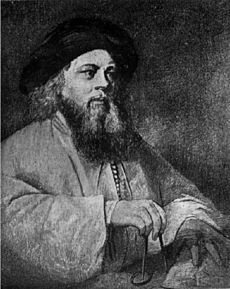
A famous painting is often thought to be of Rabbi Israel ben Eliezer. However, it is actually a portrait of Hayyim Samuel Jacob Falk. He was known as the Baal Shem of London.
In Popular Culture
In 2019, an American funk band called The Fearless Flyers released a song. It was an instrumental piece named "The Baal Shem Tov" to honor the rabbi.
See also
 In Spanish: Israel ben Eliezer para niños
In Spanish: Israel ben Eliezer para niños
- Hasidic Judaism
- List of Hasidic dynasties
- Tzavaat HaRivash
- Baal Shem Tov family tree


